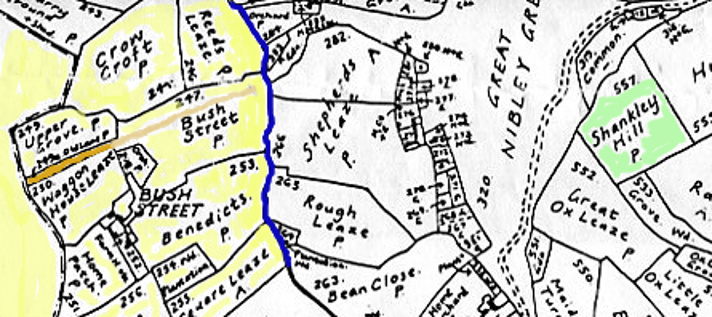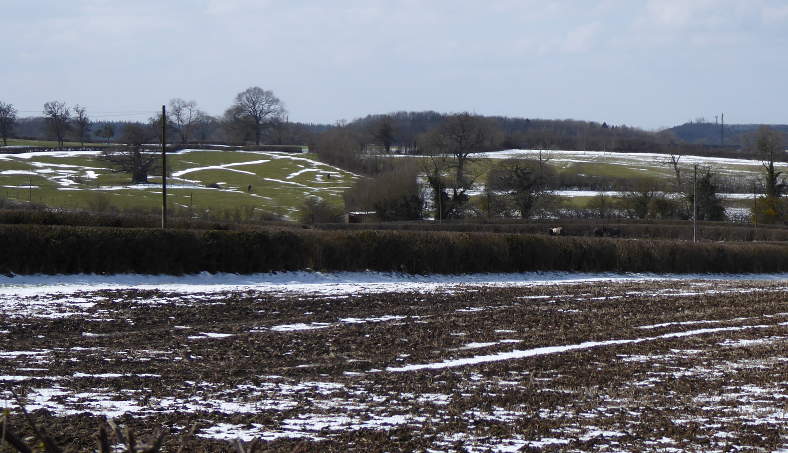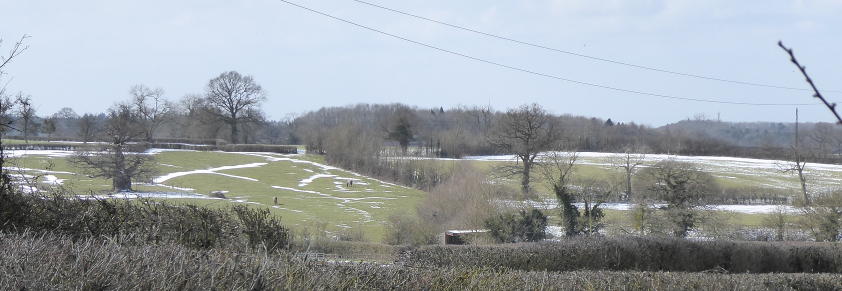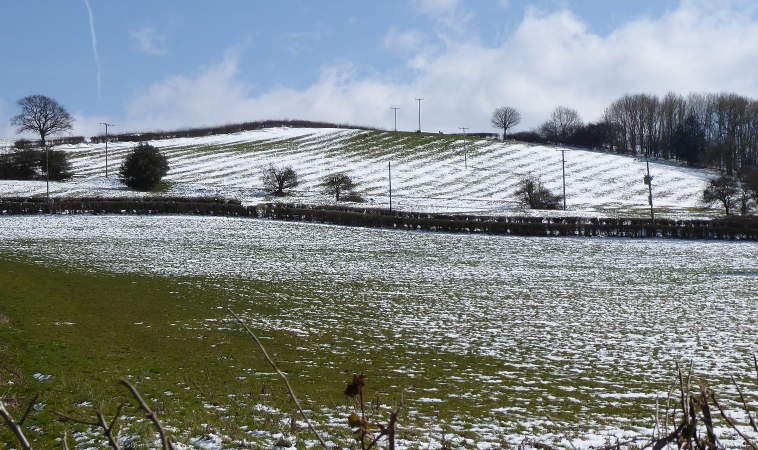Battle of Nibley Green
The parish of North Nibley was the scene of the last battle fought in England between private armies. The main protaganists were Thomas, Lord Lisle and William, Lord Berkeley with combined forces in excess of 1,000 men. The battle took place on 20th March 1470* at Nibley Green. The exact site of the battle has not been established but ranged over an area between Michelwood and St Martin's church. Lord Berkeley's men emerged from the wood which at that time extended almost to the Swynbourne stream. Lord Lisle and his men descended from Shankley Hill just southwest of the church. The whole area north of Basset Court farm including the Isle of Rhe and the area now known as Nibley Green was open land, part of the medieval field system. The two armies met in a large area of flat land centred around what is now Corner Farm. Common sense tells you that 1,000 men ranged in battle would not be contained in a small area. The battle would have covered a large area as it progressed and the defeated Lisle forces retreated north, east and south but mainly east up the hill to the church pursued by Berkeley's forces. It is estimated that over one hundred men were killed. Some of the bodies were retrieved by their families but unclaimed bodies could have been buried on the site. A mass grave is known to exist in St Martin's churchyard, presumably Lisle's men. The known accounts of the battle were written down many years later and are in any case sketchy.
The battle is not part of any specific campaign such as the War of the Roses but was to settle long running disputes between the two families over the title to land and properties. It is accepted that Lord Lisle called out Lord Berkeley in a fight to settle the disputes either in person or with their own forces. It is possible that Lord Berkeley provoked this at a time when he had a large garrison at Berkeley due to an incident a few weeks before. Lord Berkeley would have known that Lisle could not muster as large a force in a short time.
Extracts from Gloucestershire's Forgotten Battle, Nibley Green 1470
by Peter Fleming and Michael Wood.
the probability, then is that Berkeley Castle and its environs was already accommodating a sizeable proportion of the men that would fight for Lord Berkeley at Nibley Green. Such a state of readiness could not be sustained for very long (it had been seven weeks since the discovery of the plot), and so it is likely that Berkeley had in some way provoked Lord Lisle into this action, knowing that he was better prepared than his adversary. The fact that he gave Lisle only until the following morning to raise his forces might suggest this. While Lisle had some Gloucestershire manors, his main strength probably lay outside the county. His known supporters at Nibley Green came from a very restricted area encompassing Wotton, Dursley, Stroud and Tetbury. The longer Berkeley waited, the more time Lisle had to bring in reinforcements from further afield: Berkeley's men on the other hand, are likely to have been numerous, ready and waiting.
Reconstructing the battle itself is difficult. Apart from their detailed and gory descriptions of the murders, the two King's bench suits supply only places and times: Viscount Lisle was killed at ten o'clock on the morning of 20 March at Nibley Green; John Lewis met his fate on the same day, in the same place, but an hour later. neither mention that the killings took place during the course of a battle. Given that the affair was illegal, it is perhaps not surprising that neither plaintiff wished to dwell on the circumstances that brought their husbands to Nibley Green on that day. In addition, presenting their murders as unprovoked attacks in cold blood made the crimes seem all the more heinous. Other major sources for the events of the battle itself are local and family traditions, recorded by Smyth, but also by the early Tudor antiquary John Leland, and his Elizabethan counterpart William Camden, together with the testimony from the two cases heard before the court of King's Bench. Writing in the early 1540s, John Leland, antiquarian and traveller, made two references to Nibley Green. In a section of his Itinerary dealing with Gloucestershire, Leland notes how,
Ther was great harte burning betwixt the Lorde Berkeley and the Lorde Lisle for the maner of Wotton under Egge, in so much that they pointed to fight, and meting yn a medow at a place caullid Nebley, berkeley's archers sodainly shotte sore, and the Lord Lisle lifteting up the visar of his helme was by an archer of the forest of Dene shotte in at the mouth and oute of the neck: and a few beside beying slayn Lisle men fled.
Leland returned to the subject a little later in the same section:
there hath been a very greate campe of menne of warre on an hille now caullyd nebley over growen with wodde... The Lorde Lisle was slayn with an arow by one James Hiatte of the forest of Deene yn Nebley paroch.
Leland's account, written over seventy-five years before Smyth's, and apparently unknown to him, appears to offer impressive confirmation of the latter's version of events in all but the identity of Lisle's killer (we shall return to this topic later). A note of caution is necessary, however. For local traditions to have survived for Smyth to record them, they must, of course, have been thirty-five years after the event: plenty of time for the tale to grow in the telling. The detail that the two lords 'pointed to fight' could have been derived from the roll in the Berkeley Castle muniment room.
Camden's account, contained in his Britannia, is terse, and tells us little about the battle:
... Wotton under Edge, which yet remembreth the slaughter of Sir Thomas Talbot Viscount Lisle, here slain in the time of King Edward 4. in an encounter with the Lord Barkley, about possessions, since which time hath continued suits between their Posterity until now lately they were finally compounded.
Smyth knew of Camden's work, and quotes this section in his own.
Smyth's approach to oral tradition combines fascination, caution, but perhaps also credulity. He writes,
And if traditions might bee here allowed, I would assure this noble family. That within thirty two years last, by reason of my dwelling at Nibley, and of my oft resort to Wotton and to the villages adjoyning, I have often heard many old men and weomen in those places [and here he gives the names of eleven of them]... many of whose parents lived in the time of king Edward the fourth, and most of themselves were born in the time of king Henry the seaventh, as their leases and copies declared, some of them one hundred and ten years old, divers an hundred, and none under forescore, relate the reports of their parents kinsfolks and neighbours present at the skirmish, some with the one lord, and others with the other; and of such as carryed victuals and weapons to some of those companies,... and after climbed up trees, (being then boys of twelve and sixteen yeares,) to see the battle...
At this point, however, Smyth the lawyer's scepticism reasserts itself:
But enough of these traditions and reports, wherein I have exceeded mine own Inclination because this passage is of most remarkableness in this family.
Smyth's claims for the longevity of some of his neighbours defy belief... Smyth tells us that his meetings with these ancients had taken place less than thirty-two years earlier. had they been born during the reign of Henry VII (1485-1509), as he claimed, then they would have been over seventy-seven years of age at the time of the interviews. This indeed would have been a remarkable age for the time, but not impossible... that there were as many as eleven children of the Nibley Green generation alive in 1586 for Smyth to interview is unlikely, to say the least. Smyth was not by nature gullible, and his confusion is probably explained by the uncertainty in ascertaining the ages of those born before records of baptism were regularly kept.
Four hundred years on, we are in a far worse position than Smyth to decide upon the veracity of these tales, and they should be given their due consideration alongside what scraps of evidence we have from the documentary record. Smyth claims that his informants told him of how their ancestors supplied Berkeley's army as it,
lay close in the utter skirts of Michaellwood chace, out of which this lord Berkeley brake, when hee first beheld the lord Lisle with his fellowship descending down the hill from Nibley Church... And how the lord Berkeleys number was about one thousand, and exceeded the other in greatness: that the place of stand was at fowleshard, whence this lord Will[ia]m sent upon the lord Lisle the first shower of his arrowes; That one Black Will, (soe called) should shoot the lord Lisle, as his beaver was up; And that Thomas Longe father of the said Will[ia]m [one of Smyth's informants] was servant to one of them who helped to carry the lord Lisle when hee was slayne, And that a spetial man of the lord Lisles company was then slaine, and buryed under the great stone tomb which yet remaines in the south side of Nibley Church yard.
Literary and record sources for the deployment of forces and the course of the battle are sparse and problematic. Luckily, the general topography of Nibley Green appears to have changed little since 1470 - at least, the battlefield has not disappeared under a housing estate or car park - and the landscape itself can provide valuable evidence.
Nibley Green extends around Shankley Hill, on which stands the village and church of North Nibley. The green was created around 1300 as one of the assarts carved out of Michaelwood (the 'mickle', or 'great' wood) by the second Lord Thomas Berkeley. Michaelwood Chase lay to the south-west of Shankley Hill: its borders have gradually receded over the centuries, but in 1470 it probably extended as far as the Swynbourne Stream. Had Berkeleys's men issued from Michaelwood, as Smyth records, then the battle would have taken place in the south-western part of the green. Lisle was marching towards Nibley Green from Wotton-under-Edge, and the road ran along the top of Shankley Hill, through the village. Lisle's force would have been positioned first at the top of Shankley Hill before descending to the green. Smyth names 'Fowleshard' as the scene of the fighting. The place-name element 'hard' usually refers to a firm piece of land in the middle of a mash or bog. The Swynbourne Stream often makes the southern part of the green very boggy. Fowles Grove is recorded in medieval deeds as covering about seven acres {its exact position is subject to speculation}. This was the battleground selected by William Lord Berkeley. At first sight, it does not appear well-chosen. Lisle, on Shankley Hill, had the advantage of height. No deployment on the green could escape his gaze. His forces were well beyond bowshot of any archers deployed at the edge of Michaelwood, and to move within effective range would have exposed them to Lisle's archers, who had the benefit of shooting down the slope. The site appeared to offer Lisle all the advantages; in fact Lisle may have walked into a trap.
Berkeley had appointed eight in the morning as the time of their meeting. In mid-March in this part of England the sun rises at around six, giving Berkeley two hours of daylight to reach Nibley Green from Berkeley Castle, five miles (8km) away. The King's Bench pleas give ten and eleven as the hours at which fighting took place: clocks were scarce (was there a clock on Nibley Church tower?) and telling the time accurately by other means was difficult, so we should probably not take too much of the difference of one hour. However, this testimony does suggest that there may have been a delay of up to three hours between the arrival of the two forces and the outbreak of hostilities. Was the time spent goading, or persuading, Lisle down from Shankley Hill?
Shankley Hill rises eighty metres above Nibley Green and its south-western slope has a one-in-five gradient. Standing at its summit, Lisle was in an almost impregnable position. Why did he surreneder it? There are two possible answers. The first is that Berkeley asked hime to come down, and he agreed. This might sound incredible, but it would have been entirely in keeping with chivalric concepts of honour. Lisle, if we are to believe that the text of his challenge is genuine, had called for this battle, and the onus was on hime to conduct himself in a manner that ensured a fair and honourable fight. Expecting his opponent to labour up Shankley Hill under showers of arrows would not have been regarded as fair and honourable. Berkeley could have refused to give battle in these circumstances, and he would have received a favourable hearing had he then blamed the non-event on Lisle's cowardice, not his own.
the second explanation is that Lisle move onto Nibley Green because he thought it would bring him a tactical advantage. This is conceivable if what he saw below him was a smaller force than his own, and he believed that he could sweep it off the field with the impetus of a downhill charge. Smyth believed that Berkeley's force was the larger, and this would seem to be borne out by what we know of those individuals who were present. Smyth records the tradition that Berkeley's men broke from the cover of Michaelwood when they saw Lisle's force coming down the hill: if true, this might seem to invalidate the first explanation, since it implies that Lisle was unaware of their presence when he began his descent. However he must have known that at least some of Berkelely's men were present, if we are to believe Smyth's story of local people supplying Berkeley's force as it lay in the woods, since these victuallers would have been visible from Lisle's position, and anyway, he was of course expecting Berkeley's men to be there. What drew him down may have been a smaller body of men deployed by Berkeley for this very purpose in front of Michaelwood, and perhaps behind the Swynebourne Stream. This would have been a detachment, big enough to convince Lisle that it constituted Berkeley's entire army, and perhaps bearing aloft his banner. Berkeley may have had this tactic already in mind the day before, when composing his response to Lisle's challenge (again assuming it is genuine). Noting Lisle's demand 'that I should bee there with all the power that I could make', he went on to assure his opponent that, 'I will not bring the tenth part that I can make...'. Was this 'tenth part' destined to be the bait in Berkeley's trap? believing this detachment to be the entire enemy force, perhaps assuming that Berkeley's reinforcements had not yet reached him, Lisle may have seized what he took to be his golden opportunity, and charged down the hill. The steep descent may have caused some disorder among his troops. They would have been further impeded by the soft ground as they neared Swynebourne Stream, and by this time they would have been under arrow shot. The maximum effective range of a bow was about 180 metres. A competent archer could discharge ten arrows a minute. assuming that Lisle's men, advancing on foot across difficult terrain, and moving only as fast as their heavily armoured leaders, were walking at between two and three miles per hour, they would have been under arrow shot for three to four minutes: time enough to receive as many as forty volleys. They would have taken significant casualties as they advanced across Nibley Green. Once engaged with their forward detachment, Lisle's men could not have broken off in good order if they discovered that they had walked into an ambush as the rest of Berkeley's army appeared out of the trees.
Alternatively, Lisle's force may not even have got as far as engaging with the enemy. The testimonies of Leland, Smyth and Margaret Viscountess Lisle agree that Lisle was shot early in the encounter, and Leland believed that soon after this his army fled. This is entirely likely, since even in the most professional and well-disciplined of medieval armies the death of the commander could have fatal consequences for morale, resulting in a panic-stricken rout. Lisle's force would have been composed largely of tenants, whose main aim on the day was not to get killed. Seeing their master go down, and faced with superior numbers, their most likely reaction would have been flight. Lisle's death was the decisive event of the battle, as well as being a turning point in the wider saga of the Berkeley dispute. How exactly did it happen?
published by Tempus Publishing Ltd, Stroud 2003

Tithe map circa 1847.
The area coloured yellow was most likely part of Michaelwood at the time of the battle. The Swynbourne stream is coloured blue. Part of Shankley Hill is coloured green. The track coloured brown was considered old in 1847.

Site of the battle 2019
Note the ancient tree to the left of the telephone/power pole. This tree was within Michaelwood at the time of the battle and an ancient track emerges from the wood at this point.

Closer view
Note the ancient tree. Lord Berkeley's men probably emerged from the wood at this point and at that time the wood extended almost to the Swynbourne stream which is in the lower ground at the bottom of the field.

Shankley Hill 2019
Lord Lisle charged down this hill probably believing that his men outnumbered Berkeley's.
* There is often confusion over dates before 1752 when the official start of year changed from 25 March (Lady Day) to 1st January thereby changing January, February and March from the end of the year (in this case 1469) to the start of the next year. So the date of the Battle of Nibley Green is usually written 20 March 1469/70. 1762 is also the time when England changed from the Julian Calendar to the Gregorian 'losing' eleven days in September.